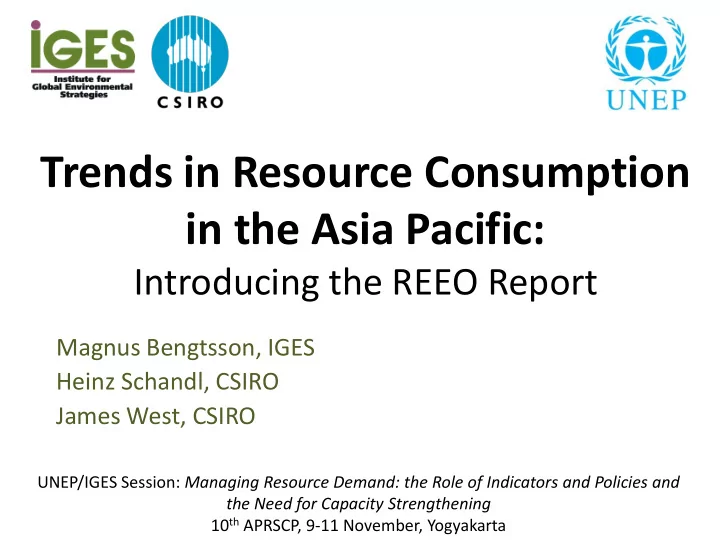

Trends in Resource Consumption in the Asia Pacific: Introducing the REEO Report Magnus Bengtsson, IGES Heinz Schandl, CSIRO James West, CSIRO UNEP/IGES Session: Managing Resource Demand: the Role of Indicators and Policies and the Need for Capacity Strengthening 10 th APRSCP, 9-11 November, Yogyakarta
Outline 1. The REEO Study 2. Selected Findings for Asia and the Pacific 3. Selected Findings for Indonesia
PART 1 The REEO Study
Resource Efficiency: Economics and Outlook for Asia and the Pacific (REEO) • A UNEP initiative • Conducted by CSIRO (Australia) in collaboration with Chinese Academy of Sciences, TERI (India) and IGES (Japan) • Scope: – The history, current condition and future of natural resource use in Asia and the Pacific – Materials and waste – Energy and emissions – Water and Land – Resource Efficiency – Modeling future resource use scenarios – Policies to guide sustainable use of natural resources in Asia and the Pacific countries and the region
One of the Outcomes: A Unique Database • Comprehensive data on material flows for 1970 – 2005 • Most Asian and Pacific countries covered • Data presented for biomass, fossil fuels, metal ores and industrial minerals, and construction minerals • The data covers domestic extraction, physical trade balance (imports minus exports, measured in tonnes), and domestic material consumption • The dataset was endorsed by ADB, UNESCAP and UNEP • Sources and methodologies as well as the full dataset are available at www.csiro.au/AsiaPacificMaterialFlows
PART 2 Selected Findings for Asia and the Pacific
At the beginning of the 21 st century Asia-Pacific become the world’s largest resource user 70,000 60,000 50,000 million tonnes 40,000 Asia Pacific Rest of World 30,000 World 20,000 • A significant share of the region’s resource 10,000 consumption is related with export to countries 0 outside of the region 1970 1975 1980 1985 1990 1995 2000 2005 • However, most of the years resources are used for Domestic Material Consumption (DMC) in Asia-Pacific, the world end-consumption in the and the rest of the world, 1970 -2005, million tonnes region
A doubling of the use of biomass – a six time increase in the use of non-renewable resources Domestic Material Consumption (DMC) in Asia-Pacific, 1970 -2005, million tonnes
Per Capita Resource Consumption in Asia Pacific has Increased Rapidly Asia Pacific was consuming just one third of the Rest of the World Asia Pacific is now consuming as much as the Rest of the World Per Capita Resource Use for the Asia-Pacific, Rest of World and World, for the years 1971 – 2005. (Total Domestic Material Consumption)
No Sign of Decoupling in the Region Each dollar of GDP requires increasing amounts of natural resources. Material Intensity for the Asia-Pacific, Rest of World and World, for the years 1971 – 2005. (Materials are Total Domestic Material Consumption, dollars are constant year 2000 $US, exchange rate based) 10
Possible Future Scenarios The REEO scenario modeling suggests that: Resource consumption would triple until 2050 under a business-as-usual scenario Even with efficiency improvements of 50% in key economic sectors, resource consumption would still increase drastically Large changes in how we live, eat, work and move around are needed
PART 3 Selected Findings for Indonesia
Domestic Material Consumption (DMC) for Indonesia, 1970 – 2005, million tonnes 1250 1000 Metal ores and industrial minerals million tonnes 750 Fossil Fuels Construction Minerals 500 Biomass 250 0 1970 1975 1980 1985 1990 1995 2000 2005
Total Primary Energy Supply (TPES) for Indonesia, 1970 – 2005, Peta Joule 8,000 7,000 6,000 5,000 Petroleum Non-Hydro Renewables PJ 4,000 Natural Gas Hydro Coal 3,000 2,000 1,000 - 1970 1975 1980 1985 1990 1995 2000 2005
Transitioning from an agricultural to an industrial society – from biomass and renewable energy to fossil fuels and construction minerals Domestic Material Consumption (DMC) 1970 2005 1% 5% 4% Biomass 15% Biomass Construction Minerals Construction 11% Fossil Fuels Minerals 48% Fossil Fuels Metal ores and industrial minerals Metal ores and 90% industrial minerals 26% Total Primary Energy Supply (TPES) 1970 2005 1% Coal Coal 14% 23% 0% Hydro Hydro 37% 0% Natural Gas 17% Natural Gas Non-Hydro Non-Hydro Renewables Renewables 0% 76% Petroleum Petroleum 32%
Evolution of GDP and factor productivities for Indonesia, 1970 – 2005, indexed 800 700 600 Index 1970 = 100 500 GDP Labour Productivity 400 Material Productivity 300 Energy Productivity 200 100 - 1970 1975 1980 1985 1990 1995 2000 2005 Labour Productivity has improved but Material and Energy Productivity are lagging behind
Material and Energy Cost of Human Development in Indonesia, 1980 - 2005 0.600 0.600 R² = 0.9529 R² = 0.954 0.550 0.550 0.500 0.500 HDI HDI 0.450 0.450 0.400 0.400 0.350 0.350 2,000 4,000 6,000 8,000 250 750 1250 TPES [Peta Joule} DMC [million tonnes] Human development requires increasing amounts of resources and energy. Education and literacy improvements require few resources., increases in life expectancy more resources, increases in GDP/capita requires large resource inputs
Summing up • The region is rapidly transforming from agricultural to industrial, with soaring resource use • Stabilised resource use and reduced environmental damage require drastic changes in the way society produces and consumes – the lifestyles and globalised production patterns of industrialised countries are not viable models to follow • The needs for food, housing, water, energy and transportation have to be met in much smarter ways than now. • Such changes require structural changes – Values and mindsets – Business models – Balance between paid work and leisure time – Political priorities and ways of delivering human wellbeing, for example less emphasis on GDP – Stronger and more integrated policies addressing whole value chains from a life-cycle perspective.
Thank you for your attention Terima kasih Magnus Bengtsson, bengtsson@iges.or.jp
Recommend
More recommend